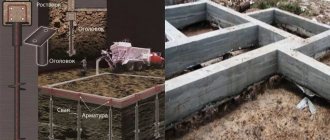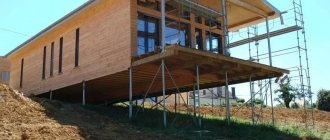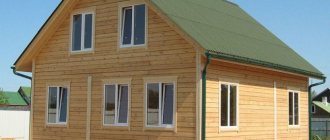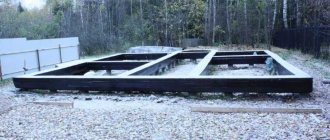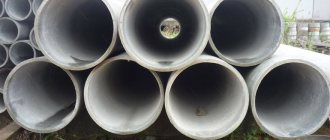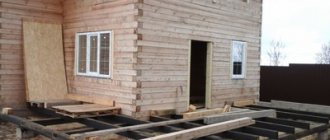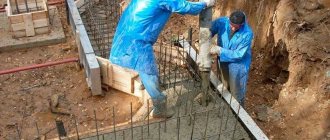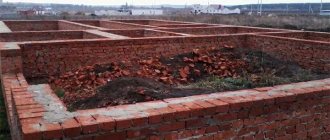When building a house, great importance is given to the construction of the foundation. We have said more than once that the foundation is the foundation of the future home. That's why it needs to be taken seriously. The soil and soil quality of the area where the house will be built is of key importance when choosing the type of foundation. Today we will look at the pros and cons of a pile foundation. The entire construction technology depends on the type of soil on the site, so before starting to build a house, we recommend that you definitely do geotechnical surveys. This will allow you to accurately determine the type of foundation for building your home.
In many regions of Russia, swampy, flooded or weak-bearing soils predominate. This makes the construction process problematic. This is especially true for the construction of private houses. But nevertheless, it is necessary to build somehow, and the use of a traditional strip or even slab foundation on such soils is simply unacceptable. In such cases, a pile foundation comes to the rescue. It is based on the installation of supporting structures. Such structures ensure good contact of the future house with dense layers of soil. And most importantly, they allow you to build very large and massive structures without fear for their stability. But is such a foundation good and safe? Are there any disadvantages of a pile foundation and what are they? Let's sort it out in order.
An example of a pile foundation for a house
Next, we will examine in detail the lighter version of the pile foundation. This includes screw piles. We'll tell you how to install screw piles so that they don't fail. And also what are the advantages of screw piles for the foundation of a house.
Foundation on screw piles
What are screw piles? What are their features and convenience? And how to make a foundation with their help? Screw piles are such a support structure. It is a system of pipes that are immersed in the ground to a certain depth. Spiral blades are welded at the bottom of these pipes (as in the photo). This design allows you to screw piles into the ground. And the blades play the role of cutting, with approximately the same effect as on screws. The sharp tip of the pile makes it easier for it to penetrate the ground. And the thread, in addition to being used for screwing, is also a support unit on which the pile actually rests.
How is the support supported and how reliable is it, you ask? We answer: such a pile is supported by the friction force that occurs between the soil and the side surfaces of the pile (pipe). This design is reinforced by the same blades that we have already talked about. They bear part of the load, which makes such a support very reliable, with proper installation, of course. By the way, the installation of such piles itself has a lot of subtleties that must be observed. Failure to comply with them may result in the pile being flimsy and unreliable. So, in order to evenly distribute the load on each pile, the installation is carried out according to a pre-calculated scheme. A so-called pile field is formed. It ensures an even load on each support.
Grillage
When the piles are already immersed, their upper parts are cut off in such a way that a flat plane is obtained. Then they make a grillage or otherwise call it a load-bearing belt. This is the main structure that distributes the load from the walls. And most importantly, thanks to it, the load on the pile system is distributed evenly, without overloading any of the piles, which gives this structure reliability and durability.
The structure and functions of the grillage are very similar to the design of a strip foundation. The difference in this design is that the grillage, instead of being supported on the ground, like a strip foundation, is supported on piles. In order for the structure to become rigid and less susceptible to lateral loads, the hollow tubes of the piles are filled with concrete after installation. This creates additional stability and rigidity of the structure.
Of course, there are both pros and cons of a pile foundation. But the clear advantage of screw piles is that when installing them, it is not necessary to immerse them until they come into contact with dense layers of soil, as with other piles. The peculiarity of their design allows them to reliably hold the building with sufficient penetration into the ground. Screw piles are a hanging type of piles.
Grillage arrangement
Tying screws with your own grillage
The heads are welded to the top of the pipes and tied with a grillage. This structure should be located at a height of 0.5-0.7 m from the ground.
Several types of building materials are suitable for this work: reinforced concrete, wooden beams and metal channels. Each technology has advantages and disadvantages.
Technology of strapping with various materials
When tying with reinforced concrete, removable formwork is installed around the entire perimeter. A reinforcing frame is constructed inside from corrugated reinforcement and connected to the supports. The structure is filled with concrete mortar. The advantage of reinforced concrete piping is its high load-bearing capacity. Brick houses are built using this technology.
When tying, a reinforcing frame is constructed.
For a metal grillage, a channel is attached to the ends using a weld. This design is inferior to reinforced concrete in strength, but saves time and money.
The grillage frame with a wooden beam is attached to the heads with bolts or self-tapping screws.
The logs are connected to form half a tree. This technology is suitable for log houses and frame houses.
Pros and cons of pile foundations and screw piles
Below we will try to highlight the obvious advantages of screw piles. Of course, any choice in favor of one or another method of installing a foundation depends more on the conditions that exist specifically on your site. But we decided to highlight the general advantages that will help you make a choice based on your individual conditions. And so, the advantages of screw piles include:
- Fast installation.
- Screw piles can be installed manually. This fact makes it possible to build such a foundation next to ready-made buildings.
- Price. Screw piles cost much less than other types of foundations.
- Screw piles can be reused. If the need arises, such piles can be removed and reused elsewhere.
- The big advantage is that installation of screw piles does not require excavation work.
- Screw piles allow construction in areas where there are slopes or folds in the terrain.
- Another important advantage is that during installation you do not need to use complex equipment, which makes the installation process easier and cheaper.
The advantages of screw piles
The disadvantages of a pile foundation and screw piles in particular are given below. The disadvantages are associated not with the structure itself, but with the conditions in which it is unacceptable to use this type of foundation. Here's what it includes:
- Corrosion may appear on the piles, as operating conditions contribute to this.
- In regions where there is high seismic activity, the use of screw piles is prohibited.
- Do not immerse in rocky soil.
- If you plan to install screw piles on loose and weak-bearing soils that do not provide acceptable lateral support for the piles, then additional study is required to determine the sufficient immersion depth of the screw piles.
Often, as it happens, many of the shortcomings of screw piles are deliberately hushed up by manufacturers. In this regard, when choosing a pile type of foundation, you need to understand the design features yourself or have a trusted person who understands this. And most importantly, have an idea of the properties of such piles. To choose the most suitable and high-quality option for screw piles.
Screw pile design
Building a foundation structure for a house with your own hands
Technological stages of construction (after calculations and design):
- site marking;
- screwing in piles using a nozzle and profile pipe-levers;
- concreting the pipe cavity to increase strength and prevent condensation;
- cutting piles at one level;
- welding of ends.
What should be the distance between screw piles when constructing a foundation can be found out here. Read about installing screw piles for a foundation with your own hands in this article, about repairing a foundation using screw supports in this one, about reconstructing a foundation in this one.
Sewage device
When installing sewerage in a house on stilts, it is necessary to insulate the pipes to avoid freezing of the waste liquid when the air temperature is negative.
To do this you need:
- Use thermal insulation materials for pipes.
- Insulate the basement around the perimeter of the house.
- Lay an external drain pipe connecting the internal sewerage system to the septic tank in a trench.
Barn from scratch
The shed is a lightweight structure, so pipes with a diameter of less than 108 mm can be used for the foundation. The length of the pipes is selected taking into account the depth of soil freezing (1.5–2 meters).
Three people can install such piles in a day: two tighten the supports, one controls the vertical level. If the size of the building does not exceed an area of 3 by 3 meters, it is enough to install 4 pipes at the corners of the structure.
After installing the supports, concreting is carried out, the protruding parts of the pipes are cut off at the same level and the ends are welded. The piles can be tied into a single structure using a channel, a metal pipe or wooden beams.
Construction of a veranda
Each corner of the veranda should be supported by one support. In this way, the number of rods is selected, taking into account that the step between them should not exceed 3 m. The length of the pipes depends on the freezing line of the soil. The diameter of the support can be chosen between 57 and 89 mm.
Stages of work:
- screw the supports in a strictly vertical position;
- cut pipes at the same level
- fill the cavity with concrete;
- weld the head;
- a layer of waterproofing is placed on the heads;
- make the strapping with a grillage (metal profile or beams).
Any wood used in construction must be treated with moisture-resistant impregnation.
Unlike a separate terrace, the veranda has at least one wall with the house and is connected by a roof. In this case, builders advise making a connection between the foundations so as not to disrupt the stability of the structure .
For a terrace separate from the house, you need to calculate the total loads, analyze the bearing capacity of the soil and, in connection with these data, select the number of supports. To increase the stability of the terrace, it is recommended to do the strapping both along the perimeter and diagonally.
What are the types of screw piles?
Screw piles come in various types. They are used depending on soil conditions and other parameters that we will consider. So what are the types of screw supports that are used in the world of modern construction? For convenience, we will divide all types of screw piles into categories.
By area of application in construction
For those who know little about the construction craft, it seems that this type of foundation is used very rarely. But that's not true. This type is used much more widely.
Below we list the areas in which pile structures, screw piles in particular, are widely used:
- Capital construction.
- Individual construction for housing.
- Construction of greenhouses.
- Construction of hangars.
- Fences or enclosures, etc.
- Bridges, piers and other hydraulic structures.
- Load-bearing supports of power lines, masts, etc.
Over the past few decades, the popularity of this type of base has increased significantly. This means that the scope of application of screw piles is only growing and this process is not over yet.
Screw piles design
What are the sizes of piles?
In the manufacture of screw piles, steel pipes of different diameters . Depending on the application, different pile sizes are used. The larger the scale of construction, the thicker the piles should be, this is understandable. But the most common are pipes with a diameter of 108 mm. This size optimally combines fairly good penetration into the ground and high load-bearing capacity.
The diameter range of pile pipes ranges from 57-219 mm. Of course, in some cases, pipes with a larger diameter can be used.
Since the topic of this article is devoted specifically to private housing construction, we will make an amendment that pipes over 159 mm are usually not used. Since with such a thickness there are already certain difficulties in driving piles.
The length of the piles is also key and has several options. Standard sizes range from 1650 mm to 9000 mm. The length of the piles is selected depending on the conditions in which the building must be erected. It is important to understand that the more complex the soil area, the longer the length should be chosen when using piles.
How many blades should there be?
Piles come in various designs. Designs come with one blade or with several blades. Single-blade piles are usually used only on relatively stable soils. Piles with several blades are more suitable for complex and low-bearing soils.
It is important to know. In order not to lose traction with the ground when installing piles, you cannot reverse (reverse movement when screwing in). And also the load on the pile should not be exceeded.
Of course, when constructing important buildings, especially if the soil is weak-bearing, then it is necessary to use multi-bladed piles. Since their design provides greater stability and can withstand higher loads. This is a definite plus in favor of choosing multi-bladed screw piles.
Types of piles
For critical buildings on weak-bearing soils, multi-bladed piles are used, which demonstrate greater resistance to possible loads. Also, an additional argument in favor of choosing just such piles can be the fact that with an increase in the number of blades on the pile, it becomes possible to reduce the diameter of the trunk. And this makes it much easier to dive into the ground.
But it is imperative to ensure that the wall thickness provides the required structural rigidity.
Types of screw pile tips
The main function of the tips is to take on the load when the pile is driven. Therefore, this creates high demands on this structural element. Let's take a closer look at what types of tips there are for screw piles and in which cases which tip is best to use.
Types of screw piles
There are the following types of screw pile tips:
- The first type of tips is welded screw pile tips . They are made by narrowing the thickness of the pipe. Wedge-shaped sections of the pipe are cut out, and then the remaining parts are connected in such a way that a cone is obtained. Next, the seams are welded into a single structure. In this way, a pointed end is achieved. But it is worth noting that this type is only suitable for relatively weak soils. Otherwise, possible obstacles and inclusions of hard areas will simply destroy such a tip.
- The second type of tips, which is distinguished by its reliability and durability, is the cast tips of screw piles. They are made by casting from durable steel, and then additionally attached to the pipe. Such tips are massive, have greater thickness and have the ability to destroy inclusions that occur when installed in the ground. These tips are perfect for difficult soils that have a high density.
Screw pile options
What material are screw piles made of?
The material used for making screw piles is, of course, steel, but the grade of steel may vary depending on the level of construction. Of course, the material directly affects the cost of the pile, so the higher the steel grade, the higher the cost. Usually they use steel from the usual St3 to the more durable St20. If it is necessary to build in highly aggressive soils, where the loads are high and there is the possibility of electrostatic corrosion of the material, fairly durable steel grades 30 KhMA and 09G2S can be used. Below is a table of properties for different grades of steel.
Properties table for various steel grades
Type of protective coating for screw piles
The protective layer that covers ready-made piles is of great importance. Zinc is most often used for these purposes. It is applied in layers to the piles. But the material itself must be very resistant to corrosion. This combination provides good protection, and this in turn increases the service life and reliability of the structure.
The polymer materials that are used for the coating are erased while screwing the piles into the ground, which means they do not fulfill their task. Such a coating is necessary only to protect the outer part of the pile. In addition, this coating requires regular updating.
With the advancement of construction technology, many engineers are proposing innovative methods for protecting piles. They offer different methods from mastics to a rubber layer. But such methods have not yet become widespread and popular among builders.
What it is?
A screw pile is a pipe with a sharp tip and a screwed-on blade. Thanks to this design, the support is screwed into the ground, compacting it with each turn. The bearing capacity of the foundation is determined by the size of the pipes and the configuration of their blades.
Advantages and disadvantages of such a foundation
The technology using a pile-screw foundation is distinguished by the following features:
installation from one day;- possibility of construction on difficult landscapes;
- cheaper price of rods compared to reinforced concrete supports;
- screwing is possible manually and mechanically;
- suitable for most types of soil, except rocks;
- Multiple use of piles is allowed.
Disadvantages of technology:
- difficulties in arranging basements and ground floors;
- destruction of metal under the influence of corrosive processes and the biological environment;
- not suitable for the construction of multi-storey and heavy structures.
This article will tell you more about the advantages and disadvantages of a pile-fin foundation.
Comparison of screw piles with other types of foundation
The cost of building a pile-screw foundation is 10–20% of the total cost of building a house , while for strip, slab, bored and driven reinforced concrete foundations this value reaches 30–40%. The price of a pile-screw foundation is comparable to a columnar foundation.
In terms of installation speed, screw piles can be compared to driven supports, the installation of which will take builders 1–2 days. The load-bearing capacity of metal screw rods is second only to reinforced concrete supports, which limits the scope of application of such a foundation.
A bored foundation, in turn, can withstand much greater loads than metal rods, but it requires significant financial, time and labor costs for construction.
The last problem can be solved by using screw reinforced concrete supports, but this will lead to an increase in the cost of the foundation.
Durability of supports
The declared service life of such a foundation is 70 years. In practice, the duration of operation depends on the following factors:
- Correspondence of steel strength to GOST.
- Quality of anti-corrosion coating.
- Compliance with technology during installation.
Rods protected from moisture by hot-dip galvanizing last 20 years longer than products coated with a polymer coating, bitumen mastic, primer or other types of waterproofing material.
Can the rods be installed in water?
Screw piles are used for the construction of surface structures: bridges, piers, etc. The service life of the foundation is affected by the quality of the anti-corrosion coating. For this purpose, metal piles with a protective layer applied by hot-dip galvanizing are used.
As an alternative, reinforced concrete screw supports can also be installed in water, but moisture gets into the pores of the concrete and over the years destroys such a foundation.
In such operating conditions, the size of the blades is responsible for the load-bearing capacity of the pile foundation. The screw part also provides the necessary stability to the supports during spring ice drift.
Optimal screw piles for the construction of a private house
Of course, you must understand that without a preliminary analysis of the soil and the state of the area, it is simply not possible to say that some piles are suitable and others are not. You also need to take into account the weight of the future house, and for this you need to calculate it at the beginning (in this article there are calculation formulas for a slab foundation, but the weight of the house does not change depending on the type of foundation). The table will help you.
Weight calculation
If we proceed from the specifics of the construction, which involves the creation of a relatively light house with a small number of floors, then the most appropriate option would be to use single-bladed trunks with a diameter of 57 to 108 mm, depending on the type and condition of the soil .
Let's take the following data as an example. We are planning to build a relatively light house with a small number of floors. Based on these conditions, the most suitable option would be to use single-blade piles with a diameter of 57 mm to 108 mm. Why is there such a big difference, you ask? Everything is very simple, the choice of diameter will depend on the condition and type of soil on which you plan to build the house. Of course, as we said earlier, in order to get more information and not make a mistake with the diameter and type of screw piles, it is necessary to conduct a survey of the site and a detailed study of the soil.
Another important indicator is the load that will put pressure on the pile. For example, let's say that with a diameter of 57 mm, a pile can withstand a load of approximately 800 kg . So it turns out that naming the pros and cons of a pile foundation and screw piles is not so simple. To do this, you need to know at least the construction conditions, the quality of the soil and the size of the building.
Harness
Pile foundation for a house
Comparison with other options
Only knowing all the advantages and disadvantages of the pile-screw structure, as well as the features of strip foundations with the pros and cons of the technology for constructing and operating the building fixed on it, can you make the right choice. The strip base is characterized by:
- possibility of shallow laying on dry, non-heaving soils;
- convenient arrangement of the burial space;
- the opportunity to do everything with your own hands;
- it takes a certain time for the concrete solution to completely cure;
- used to strengthen brick and concrete buildings;
- a significant increase in costs for areas with severe soil freezing.
It should be noted that the arrangement of a strip base in the cold season is accompanied by an increase in labor intensity and costs.
Strip base Source nl.decorexpro.com
There are several other types of foundations based on the use of piles, which are popular in individual construction.
Pile-tape construction
The most advanced option is considered to be a pile-strip foundation, the pros and cons of which reflect its effectiveness in the most difficult cases:
- for a building made of brick or reinforced concrete structures;
- mobile heaving soils;
- groundwater, high humidity;
- difficult terrain, slope.
Pile-strip foundation Source vologdadom.com
Piles are installed to a depth of up to 2.5 m, which ensures increased reliability and stability of the foundation of the house.
Reinforced concrete piles
The construction of a house in areas with problematic soil, including coastal areas, steep slopes, peat bogs, deep freezing, is carried out on a foundation on reinforced concrete piles, its pros and cons are as follows:
- design work is complex and must be performed by a professional;
- allows you to obtain the maximum possible stability and rigidity of the foundation;
- suitable for heavy buildings;
- high cost of materials and work;
- use of specialized equipment.
Piles made of reinforced concrete Source svoisvai.ru
The length of reinforced concrete piles reaches 11 m. In private construction, elements about 3 m long are used, which weigh at least 700 kg.
House on a pile-screw foundation Source kursremonta.ru
For what buildings is it needed?
Screw piles can be used for various buildings. World practice has shown the ability of this type of foundation to successfully work with massive, heavy and tall buildings and structures.
However, in Russia the technology for creating this foundation has not yet been developed, so they are usually limited to the construction of auxiliary or outbuildings. For residential buildings, screw piles are used reluctantly and quite rarely.
Pile foundation, screw
History of appearance
The widespread use of pile foundations became possible in the early 50s. The development of this construction technology was due to the advent of equipment for screwing in supports.
After numerous experiments, the scientific work TUVS-55, prepared by domestic scientists and builders, was published in 1955.
This work contained a large number of technical instructions on the design of pile foundations. Since then, these developments have been adopted as standards.
Screw piles are widely used for foundation construction.
The norms and rules used in the 21st century have changed somewhat, but many provisions were borrowed from TUVS-55.
Service life of screw piles
If we take ideal conditions, which means that the soil does not have a destructive effect on the pile material, there is no corrosion, and so on, then the support can last about 300 years. And if you add galvanization of the pile, then it will last for 800 years.
Such statements are made by sellers, manufacturers and marketers of screw piles. Although, if you look soberly, they don’t have much basis for such statements. The thing is that not much time has passed since the invention of screw piles. Not even 300 years old yet. This gives the right not to take such statements and tricks seriously. Of course, there are no ideal conditions, whether we like it or not, the pile will be affected, and the banal fatigue of the metal did not disappear.
Ready piles
So it turns out that the realistic service life of a pile foundation on screw piles can be considered approximately 60-75 years . This depends on the conditions in which the pile will operate and the quality of the installation, as well as compliance with recommendations during processing. But one way or another, these are not absolute values, which means deviations in any direction are possible. But here's an interesting fact. The first engineer-inventor of screw piles, who patented them, Alexander Mitchell (April 13, 1780 - June 25, 1868) built structures on screw piles. He first proposed such piles as a support in 1833 in England. And what’s interesting is that some of the buildings are still standing and in use today. And almost 200 years have passed...
Alexander Mitchell aged 86 (April 13, 1780 – June 25, 1868)
Classification of construction piles
Based on the method of manufacturing load-bearing elements, two types of support piles can be distinguished:
Welded support
This design consists of several prefabricated elements - a working barrel, a steel tip and spiral coils, interconnected by welding. This is the cheapest option for manufacturing load-bearing structures, which is suitable for the construction of private houses and commercial buildings.
But in industrial construction, welded piles are practically not used. The fact is that during the operation of such a foundation, corrosion destruction of metals and, above all, welded joints occurs. This structure is considered not strong enough and not reliable enough to build multi-story structures and industrial facilities on it. In some cases, to strengthen it, a concrete mixture is poured inside the working shaft.
Support with molded tip
This type of support is a cast structure of the tip and a spiral coil wrapping around it. There are no seams between the two structural elements, which significantly increases the strength of the support and minimizes the problem of corrosion damage to the structure. In this case, the weld between the tip and the working shaft still remains, but the length of the seam and the direction of the force on the pile are such that you don’t have to worry about tearing off the tip and destroying the structure.
Practice shows that piles with a cast tip structure easily penetrate the soil, passing through the root system of trees without problems and without deforming when colliding with rocky inclusions. These piles are suitable for the construction of critical structures bearing increased loads. True, the cost of these products is so high that they are practically not used in private construction.
According to the type of construction, piles are divided into 4 types:
1. Wideband piles with one screw
This most common type of construction is a pile with one turn, which is located at the tip of the support. This simple design has a fairly attractive price and can be used for building a foundation for outbuildings, as well as for constructing a one-story private house from frame panels. What is typical is that you can even screw such a structure into the ground with your own hands, without the use of special equipment. It is enough to have only 2-3 assistants. By the way, for this purpose there are holes in the upper part of the trunk that facilitate the process of screwing the support into the ground.
2. Wideband piles with two screws
This design is very similar in shape to a broad-band pile with one screw, the only difference being that it has a similar screw on the working shaft. This makes the support even more stable and significantly increases its load-bearing capacity, because its contact area with the ground is twice as large. This type of piles is used for the construction of foundations for two-story houses, as well as for heavy one-story structures made of brick. True, such piles are rarely used in private construction, because it is almost impossible to screw them into the ground without the help of special equipment.
3. Narrow strip piles with conical screw
For such piles, the width of the screws is much narrower and more reminiscent of a thread. In this case, the spiral winding wraps around the entire pointed tip, which is much longer in shape than in the broadband version. Such piles are special because they are used for building foundations on rocky soil. These piles are also designed to create support for a one-story building.
4. Specialized narrow strip piles
Specialized narrow-band piles include tubular supports installed in conditions of deeply frozen soils (in regions characterized by permafrost). Such piles do not have a tip, there is only a lead-in turn, and at the end of the working shaft there are carbide teeth for cutting through frozen soil.
Characteristics of the body of the support-screw pile
The supporting piles also differ in the diameter of the working shaft. In this regard, there are 5 main pipe sizes:
- 57, 76 and 89 mm - this is a group of the lightest piles that are used as foundations for outbuildings (fences, gazebos, verandas and sheds);
- 108 and 133 mm - from these supports you can build a foundation for medium-sized and also relatively heavy buildings. For example, such piles are suitable as a basis for a panel house, a country house made of timber, as well as one-story houses made of foam concrete and wood.
Important! The key characteristic of the pile is the thickness of the pipe wall, as well as the corrosion resistance of the metal structure. For piles that are assembled by welding, the wall thickness rarely exceeds 5-6 mm, and the maximum load on 1 support turns out to be no more than 1,000 kg. That is why such supports are used exclusively for light outbuildings. To build a real one-story residential building from cylindrical timber or foam concrete, the thickness of the pipe in the piles must be at least 12 mm. One such pipe with a maximum diameter of 133 mm can withstand a load of at least 6,000 kg.
Can a pile foundation be considered capital?
Screw piles that are screwed into the ground can really withstand enormous loads. And be the foundation for heavy and massive structures. This gives grounds to rightfully consider foundations on screw piles not just full-fledged capital ones, but also very reliable.
In this matter, a certain psychological imbalance arises, since outwardly they do not look like a reliable support corresponding to the term “capital”.
Often people are scared by the appearance of such a design. From the outside, the piles look very flimsy and it’s hard to believe that such a support can support a large house. Because of this appearance, people simply have an imbalance. How can “this” be called “capital”? But engineers say the opposite; an indicative factor is that it is allowed to build residential buildings on pile foundations. This allows us to say with confidence that screw piles are a reliable and permanent type of foundation .
House on screw stilts
How to make the right choice?
Having learned most of the pros and cons of a pile foundation, a logical question arises. How to choose screw piles, what you need to pay attention to when choosing so that they last a long time. When choosing screw piles, you need to concentrate on two components of this process.
- Determine the standard size and type of screw piles that are suitable specifically for your conditions, your soil and your house design.
- Directly select products that suit you, taking into account their quality and price.
When working with a construction company, these two stages are reduced to a minimum of your attention. The first stage is most often decided at the design stage of the future home. But the second stage is a question for the employees of the company that is building your house.
It also happens that you build a house yourself. Read about the pros and cons of such construction in the previous article. In this case, you need to choose screw piles personally. Here is a list of what you need to pay attention to when choosing screw piles.
- The pipe must have a wall thickness of at least 4 mm.
- The pile blade must have a thickness of at least 5 mm.
- Monitor the quality of welding and weld seams, they should be of the highest quality.
- A layer of galvanization is required; this will provide additional protection and increase service life.
- The tip matters too. We talked about their types. It is advisable to choose a higher quality one.
These few points will help you choose the best product. Do not choose piles based only on price, otherwise you will have to lose a lot more effort, time and money when demolishing an already finished house. Focus only on quality. If you are in doubt and feel that a certain type of product does not fully meet your requirements, it is better to refuse such a purchase. Otherwise more problems will arise.
Pros and cons of a pile foundation. Screw piles
Screw piles, product prices
Like any other parameters, the cost is calculated based on the conditions of future construction. Therefore, each individual house project will have its own cost. We will take a very small project to simply show a diagram of how to calculate the cost. So that you can independently calculate the cost of a pile foundation for your project. So, our example will be as follows: we will calculate the cost of a screw-type foundation for a house 6 by 6 m. Based on the fact that the optimal layout of a pile field should consist of at least 9 piles. This is what we have.
Depending on the company and conditions, the customer will need to pay for the installation of each pile. The cost of installation will be approximately from 650 rubles to 1150 rubles per piece. And add here the price of the screw piles themselves. The price of screw piles depends on the diameter and length of the trunk. For example, BC-57, this means that a diameter of 57 mm and a length of 3 meters will cost 1100 rubles with installation or 1200 without such a service. If the product is selected BC-108, then the price, also for a 3-meter trunk, will range from 1150 rubles with installation of products and 1350 rubles without such a service.
Choosing a company for installing screw piles
Why is there a difference in price depending on the presence or absence of the installation option, you ask. It’s very simple; this move is designed to encourage the buyer to order installation of screw piles from the same company. Of course, such a choice is not always the best solution, this is due to the quality of the installation. It is necessary to study the history of installations of this company, read the reviews and only then make a final decision in favor of this option. Or, on the contrary, turn to another company that specializes in installation, and not in the sale of screw piles.
As a result, for our example, the cost of this type of foundation will be only about 20 thousand rubles. But please note that we only calculated the cost of the products themselves and their installation. You also need to add additional shipping costs and other overhead costs. keep this in mind.
Of course, depending on the company, prices may vary, but ours shows the average price. Therefore, be sure to find out the cost of all options and ask for a detailed report of what and how much it costs.
Cost calculation
How to choose the right piles
It is important to consider a number of factors:
- the presence and quality of anti-corrosion coating, which determines the period of operation;
- penetration of the weld to the full depth, it keeps the pipe from rupture when inserted into the ground.
Some manufacturers, in order to reduce the cost of their goods, save on coatings and materials for welding.
Screw piles for foundation Source dialkom-stroy.ru
Specialized organizations carry out calculations to determine the exact dimensions and number of piles, taking into account the local soil. For private facilities, pipes up to 3 m long and 57-133 mm in diameter are mainly used.
Brief and general installation diagram
Here we will very briefly, point by point, provide you with the procedure for installing screw piles. If you have never done installation before, be sure to study this material in more detail. The matter is not complicated, but there are many nuances that simply must be observed. Procedure:
- Mark the pile field.
- Screwing in piles.
- Filling pipe cavities with concrete.
- Trimming the tops to achieve a level surface.
- Install headers.
- Installation of grillage.
In modern construction, specialized machines are used to screw in piles. This machine provides better and faster installation of screw piles. And most importantly, it will ensure verticality, and there will be no rocking of the pile during screwing. And this, in turn, will give the most intimate contact with the ground. It is also advisable to treat welding areas and any damage found that appeared during the process with an anti-corrosion compound.
So we have finished studying the possible pros and cons of a pile foundation and screw piles in particular. Before you take action, be sure to read the reviews below . Since opinions about screw piles differ, and people say different things. Everything is very individual, so always choose based on your conditions for building a house.
Scheme for using screw piles
Driving screw piles
Pros and cons of a pile foundation - reviews
Nikolay 5/5
It's been standing for 7 years now. The house on screw stilts showed excellent results. There are no comments or complaints, everything is reliable and durable. There have been no problems during these seven years. Many people complain that they made a mistake with the choice of piles, saying they rust and other diseases. In my case, I somehow didn’t notice anything like that. Of course, you need to tint it occasionally, but like any iron you need to paint it, otherwise what kind of owner are you?!
Alexander 3.5/5
I think that messing with screw piles is simply dangerous. Yes, I don’t want to say anything bad about the design. But the ease of installation would seem to be a plus, but nope. This business attracts a lot of crooks. They installed piles in the sand for us. They dug holes for no reason, although it is forbidden to do so. Then they screwed one in just 1.5 m and they said that there was no further movement. The reason given was that the pile failed. Of course, I realized that things were not going well and refused their services, found another company and entered into an agreement with it. And what do you think??? For some reason, all their piles went in like clockwork and to the required depth. Therefore, I want to warn everyone that they need to watch the installation carefully. Otherwise, God forbid, the house will collapse in half a year.
Angelina 2/5
We got acquainted with piles while building a bathhouse; my husband built it on screw piles. And now he’s offering to build a house on them, but I somehow doubt and am afraid. And their service life, as they say, is 50 years. How is it usually only 40? They rust constantly and need to be painted. But the bathhouse has been working great for 4 years now and no problems. But a bathhouse is one thing, and a house is completely different. I persuade my husband not to install it; I still want reliability for the house.
Pros and cons of a pile foundation - reviews
Andrey 3.5/5
When purchasing piles, I recommend everyone to look at the protective coating layer. In most companies, they coat everything with paint, but it falls off during installation. If you suddenly have even the slightest doubt, look for other piles; there are a lot of them now. The thickness of the metal also matters a lot. It happens that when screwing them in like an accordion, they simply twist. I almost got caught while taking piles. The sellers said that everything was safe and normal. But the pipes look flimsy and are also painted with some kind of red paint. It was good to hire a man who understands it, he criticized these piles so much that he immediately abandoned them.
Victor 3/5
I built a house 8.5 by 9 m. The sway is not bad, it is especially noticeable on the second floor. 26 piles, 108 mm ones were screwed in. But problems arose with the depth; they did not enter uniformly due to the complexity of the soil. One is 1.5 m, the other is 2.5 m. It seems like they did everything wisely, they turned the machine, the harness was done properly. The reason for the swinging has not been figured out, but I personally blame the piles.
Vladislav 3.5/5
There was little time and not much money, so I decided to build a 6 by 6 country house on screw piles. I was amazed how quickly all the work was done. Literally 3 days for everything about everything. And they tied it up quickly with a grillage. And the price pleasantly surprised me; I gave it half as much as any strip foundation would cost, as they calculated for me. And you can’t make a strip foundation in 3 days. The only drawback is that you have to apply anti-corrosion agent occasionally.
Pros and cons of a pile foundation - reviews
Kirill 2/5
On the site I placed the gazebo on screw piles. But the neighbor had seen enough and built a one-and-a-half-story house on them. Of course he doesn’t complain, but I see how he crawls and works on his foundation twice a year. And it’s scary to look at, everything looks so flimsy. I think that there is no point in putting more gazebos and fences on such a foundation.
Mikhail 5/5
He built a wooden house from logs. But there wasn’t much money, I read a lot and decided to choose a foundation on screw piles. The house was small, 6 by 6. I installed 9 piles. The soil on the site is mostly loam, so we were lucky to drive it all the way to 3 meters. The check showed that the piles fit perfectly and do not wobble. Although many advised against installing piles, arguing that they were wobbly and not reliable at all. The house has been standing for two years now and I haven’t noticed any problems at all.
Peter 1.5/5
They built a frame house 6 by 9 meters. I chose the type of foundation - screw piles. The work took 3 months. At first we were very happy that we managed to build the house so quickly. But now, when I walk around the house or the washing machine is running, I can feel the vibration of the floor and walls. They say that the distances between the lags were large, but it seems to me that the piles failed.
